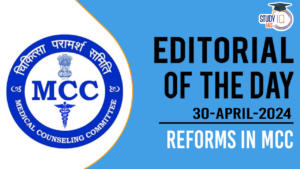Table of Contents
Context: A parliamentary panel has advised the Union government to hold discussions with stakeholders before implementing the multiple entry and exit system (MEES) under the national education policy (NEP) 2020.
About the Multiple Entry and Exit System (MEES)
- MEES is a major reform in higher education, introduced by the National Education Policy (NEP) 2020.
- It allows students to exit a program at any time with a relevant certificate, diploma, or degree, and re-enter the same program or a different program at a later time.
- Guidelines for Multiple Entry and Exit System (MEES): In accordance with NEP 2020, University Grants Commission (UGC) formulated guidelines for its implementation.
- UGC suggested a) a 3-year program and b) a 4-year program (preferred).
- To implement the MEES, the UGC asked the colleges and universities to reserve a few seats in the 2nd year, 3rd year, and 4th year of every degree program for the lateral entry of the students.
- UGC also called for the maintenance of the Academic Bank of Credits (ABC) for every student in every semester of every academic program.
Understanding the Academic Bank of Credits (ABC)
- The Academic Bank of Credits (ABC) is a digital repository of academic credits earned by students throughout their learning journey.
- It is a centralized system that allows students to transfer credits between institutions and programs, and to accumulate credits over time at their own pace.
- It was launched in 2021 as part of the National Education Policy (NEP) 2020.
- Working of the ABC:
- Being a repository of academic credits, ABC will operate as a commercial bank and Students will be its clients.
- An Academic Bank Account must be opened by students. Higher education institutions will issue credits to students for the courses they are taking on their academic accounts.
- ABC will oversee opening, closing, and certifying each student’s academic account.
- Additionally, it will carry out responsibilities including credit verification, credit accumulation, student credit transfer and redemption, and promotion of ABC among stakeholders.

Proposed Benefits of the Multiple Entry and Exit System (MEES)
- Flexibility: The ABC allows students to choose their own path and pace of learning. They can exit and re-enter programs as needed, and they can transfer credits between programs and institutions.
- Reduced dropout rates: The ABC can help to reduce dropout rates by allowing students to leave a program temporarily without losing their credits or progress. Students can then return to their studies at a later time when they are ready.
- Increased access to education: The ABC makes education more accessible to students from all walks of life. Students can choose to study full-time or part-time, and they can start and stop their studies as needed.
- Permit transdisciplinary combinations: Students will have more freedom and flexibility to enroll in or withdraw from courses as they see fit. They will also have the chance to switch courses.
- Improved workforce preparedness: The ABC can help to prepare students for the changing demands of the workforce. Students can develop the skills and knowledge they need for specific jobs, and they can easily transition to new jobs as needed.
Concerns Raised by the Parliamentary Panel
- Difficulty in predicting student intake and outflow: The panel has pointed out that it would be difficult for institutions to predict how many students would exit and how many would join midway under the MEES. This could lead to a disruption in the pupil-teacher ratio.
- Uneven Geographical Distribution: The uneven geographical distribution of higher educational institutions in India could create hurdles in managing MEES, particularly in rural areas, due to the lack of resources to cope with the increased flexibility offered by MEES.
- Lack of Clear Guidelines: Currently, there is a lack of clarity on aspects such as eligibility criteria, and credit transfer mechanisms etc. The panel has asked the government to develop comprehensive guidelines and a well-defined framework.
- Need for a standardized Credit Accumulation and Transfer (CAT) system: The panel has also called for the implementation of a standardized CAT system that would allow students to earn and transfer credits seamlessly across institutions.


 Current Affairs 30th April 2024 for UPSC...
Current Affairs 30th April 2024 for UPSC...
 Editorial of the day (30th Apr): Reforms...
Editorial of the day (30th Apr): Reforms...
 Unclassed Forests, State Expert Committe...
Unclassed Forests, State Expert Committe...

















